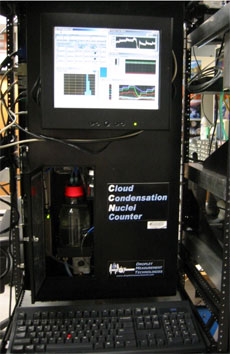New Instrument “Counts” Cloud Particles
Published: 15 September 2006

Microscopic airborne particles are commonly referred to as “aerosols.” Every one of the trillions of droplets in a cloud originates on one of these tiny “cloud condensation nuclei” (CCN). Through their role as CCN, aerosols affect cloud properties by altering the concentration of cloud droplets, and the brightness (reflectivity) and lifetime of clouds. These “indirect aerosol effects” are difficult to quantify, yet are essential to improved understanding of how clouds affect Earth’s incoming and outgoing energy. The ability to model aerosol indirect forcing is a priority for the ARM Program.
To characterize how changes in CCN concentrations may be changing the properties of clouds observed at ARM’s Southern Great Plains (SGP) site, in September a CCN Counter was added to the suite of instruments that comprise the site’s Aerosol Observing System (AOS). Built by Droplet Measurement Technologies, the instrument measures CCN number concentration at supersaturations between 0.1 – 2%. An optical particle counter measures the size distribution of the droplets that grow from CCN, collecting data every second in 20 particle size bins from 0.75 to 10 microns. Data sets from the CCN Counter at SGP will be available from the ARM Data Archive on a quarterly basis, following data quality review by the AOS instrument mentor team.
Ultimately, the goal is for AOS systems at each ARM site to use identical components, including the CCN Counter. As part of the AOS for the ARM Mobile Facility (AMF), an identical CCN instrument was deployed in 2005 during the AMF field campaign at Point Reyes, California, and is currently operating at Niamey, Niger, West Africa.
The ARM Climate Research Facility is a DOE Office of Science user facility. The ARM Facility is operated by nine DOE national laboratories, including .
Keep up with the Atmospheric Observer
Updates on ARM news, events, and opportunities delivered to your inbox
ARM User Profile
ARM welcomes users from all institutions and nations. A free ARM user account is needed to access ARM data.


















